The area of the Careenage became quite popular back in 1628 when British settlers were landing here. Not much was there with the exception of a wooden bridge across the water. It is believed that the Arawaks were the ones to create the bridge. Upon discovering the structure, the British settlers began to call the area of Bridgetown, Indian Bridge. The British removed the structure and constructed a new bridge over the Careenage sometime after 1654, and the area became known as the town of Saint Michael, and later its present day name, Bridgetown.
The Careenage was the place where ships were careened by attaching weights to the mast and pulling the ship over to one side thus exposing the hull, at which time it was cleaned of worms, moss and barnacles, repaired, scrubbed and painted. It was then turned onto the other side and the process was repeated. Other dry dock facilities were also available. This area was once filled with much activity from merchants who would dock their ships and unload all kinds of merchandise that would be stored in the nearby warehouses.
As a result of the heavy trade that once took place at the Careenage, the area was lined with warehouses that have now been converted into shops, restaurants, boutiques and bars. Despite the drastic change of appearance from then to now, the area of the Careenage still has a rather attractively old-fashioned look and feel about it.
We crossed the Careenage via Chamberlain Bridge, a liftbridge which extends from The Wharf Road/Heroes Square to Independence Square. The Chamberlain Bridge is located at the previous site of the "Indian Bridge". A horizontally swinging 39 foot steel bridge was built in 1872, so as to provide a path across the Careenage for small vessels entering the "inner basin". The bridge was later renamed after Joseph Chamberlain, who, as the British Colonial Secretary in the 1890s, was instrumental in shielding the West Indian sugar industry against stiff competition from Europe. He is also credited with allocation of large funds as grants and loans to subsist the economy of Barbados. In 2006 the old swing bridge, which was manually operated, was replaced with a modern lift bridge.
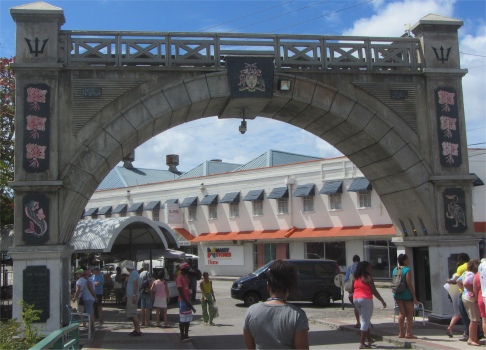
Independence Arch
|
At the southern end of the bridge is the Independence Arch, which was built in 1987 to commemorates Barbados' 21st anniversary of Independence. Until Independence was achieved on 30th November 1966, Barbados was a British colony. The arch depicts several aspects of Barbados heritage and culture. The pillars showcase two important national symbols, the flying fish and pelican, along with the Pride of Barbados flower. Across the top of the arch is the island's Coat of Arms bearing the national motto "Pride and Industry". At the base of the arch is the National Pledge:
| |
THE PLEDGE |
|
|
|
I PLEDGE ALLEGIANCE TO |
|
MY COUNTRY BARBADOS |
|
AND TO MY FLAG |
|
TO UPHOLD AND DEFEND |
|
THEIR HONOUR |
|
AND BY MY LIVING TO DO |
|
CREDIT TO MY NATION |
|
WHEREVER I GO |
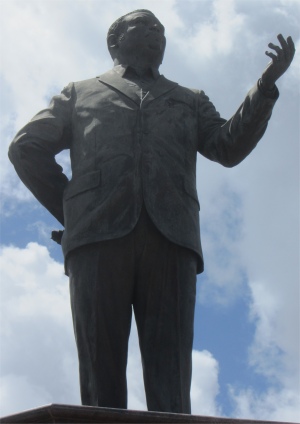
The Right Excellent Errol Walton Barrow
|
After passing through the arch, we turned left into Independence Square. In this delightful oasis, potted plants and palm trees added colour and welcome shade to the benches dotted around the area where folk sat and took in the view of the city over the Careenage. Two fountains added to the therapeutic and recreational value of the square. To add to the ambiance, and provide additional options for the use of the square, two amphitheatres have been constructed. The presence of the columns, sculptured seats and mosaics enhance the look and feel of this gift to the people of Barbados. Independence Square has been home to gospel concerts, Pan in the City, political meetings and other events conceptualized to capture the imagination and interest of the general public.
Pride of place in the square stands the 9ft statue of the Father of Independence and National Hero of Barbados, The Right Excellent Errol Walton Barrow. This new and improved Independence Square was officially opened and the statue unveiled on the day after Errol Barrow day on 22nd January 2007, almost 2 years after construction commenced in 2005.
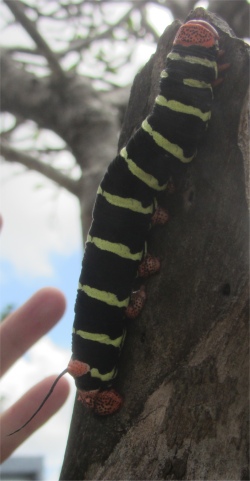
Frangipani Moth Larvae
|
Within the square stood a couple of frangipani trees, which Rex and Meryl were keen to point out to me. The trees had been almost stripped of foliage, and the reason why was clear to be seen at close up. Meryl explained that the huge caterpillars that I could now observe, like a rash all over the trees, fed primarily on the frangipani tree and plant, and would totally defoliate a tree. These huge black and white creatures, which can get up to about 15cm long, were the larvae of the frangipani moth, also known as Pseudosphinx tetrio. Rex pointed out that they can give a nasty nip, but I was not inclined to test how nasty that was. An old Japanese tourist sat underneath one of the trees, totally undeterred.
A bank just opposite the bus station near the square gave me hope of stocking up on cash. Unbelievably the bank's ATM machines would not accept my cards. I tried the tellers inside. "Sorry, I cannot dispense cash for these foreign cards. You need to cross Charles Duncan O'Neal Bridge and you will find some ATMs down there," the young teller woman informed me. I thanked her, and informed my partners in crime, who for some reason had been able to withdraw cash from the machines.
We headed across Charles Duncan O'Neal Bridge, which is just up from Chamberlain Bridge. Born in Barbados in 1879, Charles Duncan O'Neal left the island after secondary school to study medicine at Edinburgh University in Scotland. It was there that his interest in, and passion for, politics grew. During this time, he ran for a local government office and in fact won a seat, however he felt compelled to go back to Barbados and spread his socialist message around the island to his fellow Bajans. In 1910, he did return to Barbados but found the conditions so depressing that he went to live and work in Trinidad and Dominica. However, after 14 years, he was once again drawn back to his beloved island and it was in October 1924 that O'Neal founded the "radical" Democratic League political group, based on his socialist ideals. In 1932, O'Neal won a seat in the Barbados House of Assembly as a Member for Bridgetown. During his time in Parliament, he continued to fight for workers' rights, the poor and disenfranchised, and persistently campaigned for abolishing the practice of child labour.
Charles Duncan O'Neal's many achievements include the creation of a wide network of grass-root organizations - he founded the Democratic League; in 1926, set up the Working Men's Association; launched a co-operative venture in Bridgetown; and he also invested in a newspaper called "The Herald", which promoted a message of social change.
Charles O'Neal is also credited with being the first politician in Barbados to campaign for the improved conditions for women in the workplace, and supported the role women held in leadership positions in the Democratic League as well as the Working Men's Association. When this legendary Bajan passed away on 19th November 1936, he left a legacy of an increased political consciousness of the nation and social reform. In 1998, by an act of Parliament, Charles Duncan O'Neal was also publicly honoured by his mother country by being named as one of the ten official National Heroes of Barbados, which celebrates those Bajans who have made outstanding contributions to the country's history and development. As testimony to the high esteem in which O'Neal continues to be held in his homeland, you'll also find that Duncan O'Neal's portrait appears on the Bajan $10 dollar bill.
Once across the bridge my pace quickened as I was anxious to find a source of cash. By asking around, I found an ATM room attached to the RBC Royal Bank, and there all my prayers were answered; now to find Rex and Meryl who I had left far behind in my wake.
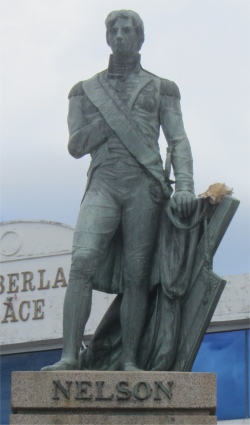
Nelson Statue
|
We were soon reunited, and we walked together to the National Heroes Square which sat by the Careenage. The square was formerly known as Trafalgar Square. Nelson was considered a hero by locals of the day for his battles against the French, who controlled some of the other islands in the Caribbean. Indeed the French and British forces were often battling for ownership of the islands with several islands changing hands frequently. Barbados on the other hand remained under British rule until independence in 1966. A large bronze statue of Lord Admiral Horatio Nelson stands in the square, which was erected in 1813 to commemorate the anniversary of the British Royal Navy's victory in the Battle of Trafalgar in 1805, and was actually there 36 years before the one in London was erected. However as this statue does not commemorate a Bajan, it was moved from its prime position to the edge of the gardens in 1990. On 22nd April 1999 the National Heroes Square name was adopted and officially took effect from 28th April 1999.
In addition to Nelson's statue, the square contains the Dolphin Fountain, which was erected to commemorate the introduction of running water to Barbados, and a War Memorial which honours those Bajans who fought in both World War I and World War II. Every year, a Remembrance Day Service is held at National Heroes Square.
National Heroes Square was transformed as a means of demonstrating gratitude for and awareness of the ten national heroes of Barbados. According to the Barbados' Order of National Heroes Act, those people that have "given outstanding service to Barbados", "contributed to the improvement of the economic and social conditions of Barbados", and demonstrated "visionary and pioneering leadership, extraordinary achievement and the attainment of the highest excellence" will be honoured every year on 28th April, a day set aside as National Heroes' Day. 28th April was chosen in honour of the birth of Sir Grantley Herbert Adams, one of the ten national heroes remembered every year.
Each of the ten received the title "Right Excellent" as part of the act. They are: Bussa, Charles Duncan O'Neal, Clement Osbourne Payne, Errol Walton Barrow, Samuel Jackman Prescod, Sarah Ann Gill, Sir Frank Walcott, Sir Garfield St. Aubrun Sobers, Sir Grantley Adams, and Sir Hugh Springer. The act was amended in 2009 to confer extra privileges to living heroes.

Parliament Buildings
|
Sadly the Parliament Buildings, that overlook National Heroes Square, were closed. These Neo-Gothic style buildings were built from local limestone and completed in 1874, and are the third oldest in the English-speaking world. The Parliament was founded in 1637, and has met regularly since 1639, and is home to the House of Assembly and Senate where stained-glass windows depict British monarchs. The west wing houses the Museum of Parliament and the National Heroes Gallery.
Leading off from the Parliament Buildings was Broad Street, the main shopping street in Barbados since the start of the 18th century. This was a colourful, vibrant and bustling street, peppered with many street vendors selling fruit, vegetables and drinks. Here, the Bajans moved more purposeful than anywhere else on the island. Everyone was smartly dressed, helpful and polite.
We stopped off at an opticians. Rex had dropped his glasses on the floor, and the top of the frame now had a bend in it, such that the lens was not seated properly. The optician, a tall, thin, friendly chap listened to Rex's tale of woe, and then went off to his workshop, Rex's glasses in hand. In less than a minute he had tightened up the lens mounting, and rendered the lenses crystal clear to boot. Rex thanked the man profusely and wanted to pay the fellow for his services.
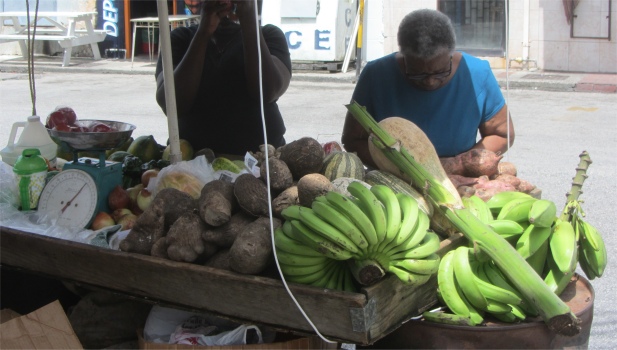
Street Vendor in Broad Street
|
The optician would not accept any payment, his services were free as far as he was concerned. "Are you going to watch the West Indies beat England on Thursday?" he asked with a broad grin on his face. That set Rex off, and there followed an interchange of banter on the forthcoming game, with Rex predicting chants of "London Bridge is Falling Down" from the locals, just had it had been two years earlier. The optician was soon rolling with laughter, and we departed the best of friends.
We entered the diamond district, and Meryl dived into one of the large jewellery stores. Rex cowered outside, chewing his fingers and smoking three cigarettes at once. He had suddenly become a shadow of his former self, and lost all his colour; a truly remarkable change.
Poor Rex needed the Last Rights, so we dragged him off to St. Michael's Cathedral. The Church of St. Michael was first built in 1628 on the site which is now occupied by the other city church, St. Mary's on Lower Broad Street. Being a wooden structure, it rotted very quickly and soon had to be replaced. The church was then rebuilt in 1641 at the present location of the Cathedral but this church too, was constructed of wood.
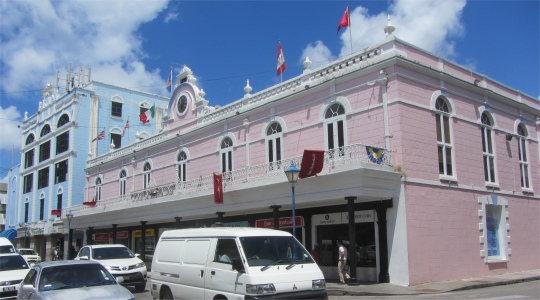
Colannade Mall in Broad Street
|
The hurricane of 1780 completely destroyed the church, and the building of a grander church was set in motion. This new church was rebuilt at its present location at a cost of about £10,000.00 which was raised by the "islanders" in a controversial lottery. This church was an even grander building with a maximum seating capacity of approximately 3000. The new coral stone building was dedicated in 1789 on the feast of St. Michael and All Angels, from which it got its name. It was elevated to Cathedral status in 1825 with the appointment of Bishop Coleridge to head the newly created Diocese of Barbados and the Leeward Islands.
I gazed up inside the building to find a beautiful barrel vaulted ceiling, and above the altar an arched ceiling (the inverted boat's prow) which resembles an upturned boat. This exceptional model of master carpentry was, at one time, considered to be the widest ceiling in the world. The cathedral also features galleries running along three sides of the church (north, south and west) as well as some very striking examples of stained glass windows. Its beautifully carved pulpit and choir stalls were all honed from the famous mahogany of Barbados. The Chapel of the Blessed Sacrament was added in 1938 and features a roof covered in wallaba heartwood shingles and a Canterbury Cross on the northern wall.
The cathedral also has some rather quirky stories attached to it. Back in the early days it was a church for the elite of the Bajan society, and as such, the black people who resided in the city and its environs were not allowed to enter the church during the services with the white worshippers. In any case, the black people still wanted to be a part of the services and they would stand outside in an alley just opposite the cathedral, where they could hear the sermons and when it was time to utter the customary "Amen", they would all join in. To this day that alley is still known as "Amen Alley".
This grand cathedral still commands that air of privilege and prestige which almost seems to be mirrored by the influential members of the Bajan society who are buried within her walls. The first prime minister of the Federation, Grantley Adams (after whom the airport in Barbados is named), his son (a former prime minister of Barbados) J.M.G.M. (Tom) Adams, a former Governor General, Sir Winston Scott, and William Brandford Griffith, former Governor of the Gold Coast, all have become a permanent part of the history of the St. Michael's Cathedral as well as that of their island home of Barbados.
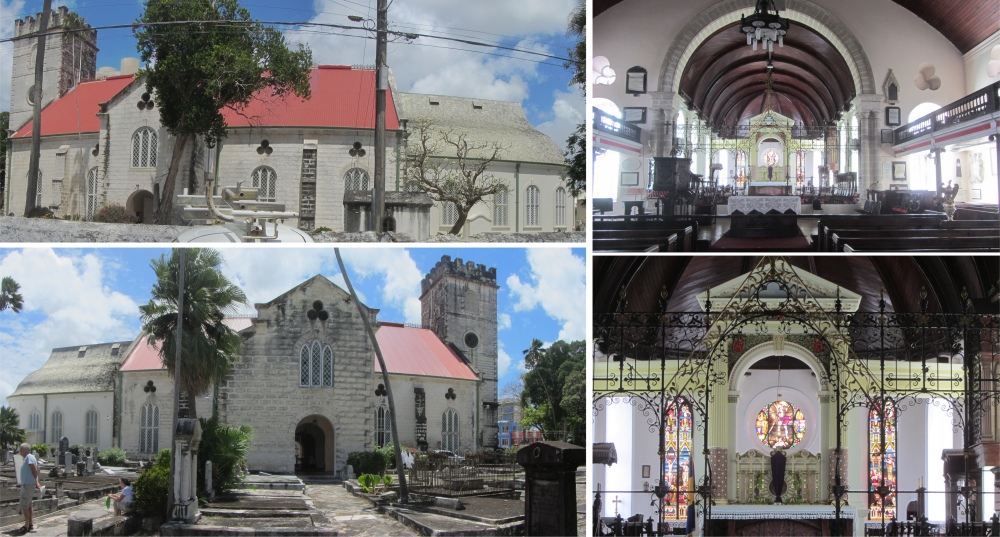
St. Michael's Cathedral
|
Having appreciated the respite from the oppressive heat, we left this magnificent building and crossed back over the Charles Duncan O'Neal Bridge where we came across a street vendor selling ackee, a fruit of yellow flesh resembling a brain, with four black spheres inside. The ackee (Blighia sapida) is a member of the Sapindaceae (soapberry family), as are the lychee and the longan. It is native to tropical West Africa. The fruit was imported to Jamaica from West Africa (probably on a slave ship) before 1778. The scientific name honours Captain William Bligh, who took the fruit from Jamaica to the Royal Botanic Gardens in Kew in 1793, and introduced it to science. Ackee is the national fruit of Jamaica, and ackee with saltfish is the Jamaican national dish.
The man plucked out the black spheres, the pips, and tossed them into the river, and then proceeded to tell me that the remaining fruit was good and created much muscle growth. Crumbs, do I look that puny? Meryl asked, "What does it taste like?"
"When you eat it raw, it tastes nutty, and when it is cooked, it tastes like egg," he answered. He was not going to let us try it for free. Observing that the locals were not interested in his wares, we left him and his spiel, and walked a little along the path between the Constitution River and Fairchild Street Bus Terminal. Large fish were lazily swimming by, and Rex spotted a turtle.
However, it was hot, and Bridgetown was losing its charm, so we headed back to base, and took ourselves off to Dover Beach for a swim and chill. The beach was crowded today, lots of pale, pasty bodies slowly roasting on sunbeds. Rex returned from his usual kilometre swim informing us he had a close encounter with a turtle. I encountered two rather large American ones on the sunbeds behind us, who were reluctant to take to the waters.
As Rob Brydon states in his cruise adverts, "This is the life."
In the evening we made for St. Lawrence Gap, and enjoyed an ice cold beer in our usual drinking hole. A chap from Saskatchewan was sitting at the bar. We chatted and discovered he had visited the island for three consecutive years with his wife to be 27 years ago. They had now returned after bringing up a family. Rex waxed lyrical about The Guess Who, a band which originated from Winnipeg, and found international success from the late 1960s through the mid-1970s with many hit singles. The whole conversation was lost on me. He had to leave to catch up with his wife, and as he did so, he smugly told us he had just been texting friends back home, where it was -20 deg. C with blizzards.
We ate in the Harlequin again. I chatted with the owner, a fellow who hailed from Reading. He was telling us how business had tailed off a little since Brexit. They had held their prices, but the value of the pound had plummeted. In a few months, in the Bajan summertime, custom traditionally drops off since folk are deterred by the heat, humidity and rain.
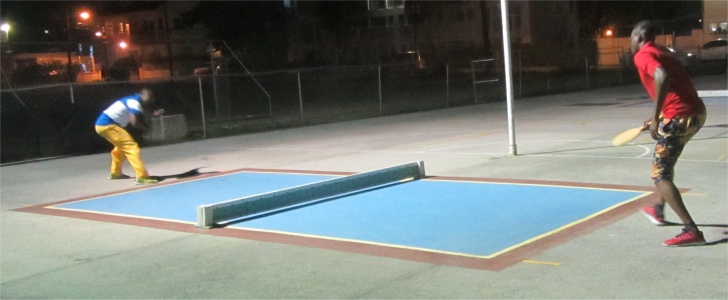
Barbados Road Tennis
|
On the walk home we stopped off to watch a game of Barbados Road Tennis taking place. There is nominal equipment: an 8 inch net, a tennis ball (bald is fine) and wooden paddles. With its fast, close volleys, it looks like table tennis outdoors ... without a table. The court can be the road; internationally it is played on tarmac on a 21ft by 10ft court. The court we were watching was of tarmac set off the road. I can't imagine the strain it puts on the players' backs.
As we sat watching, we got chatting with another spectator, a chap from Montreal (the place is full of Canadians), who was interested in the rules of cricket. I found out his grandfathers came from Manningtree and had been professional golfers. They had acquired the skills of designing and landscaping golf courses, and had brought the skills across to Canada after the First World War. Sadly, he was distracted by friends before we could carry the conversation further.
We slowly walked back to Mike's bungalow, the evening still warm, and the town bustling and throbbing with music and hidden discos.










